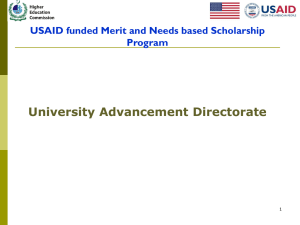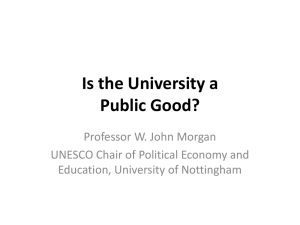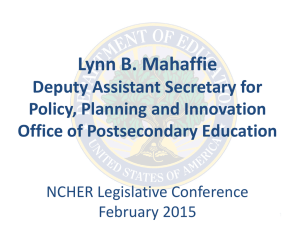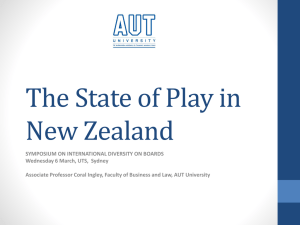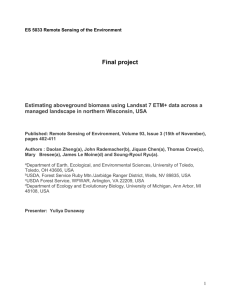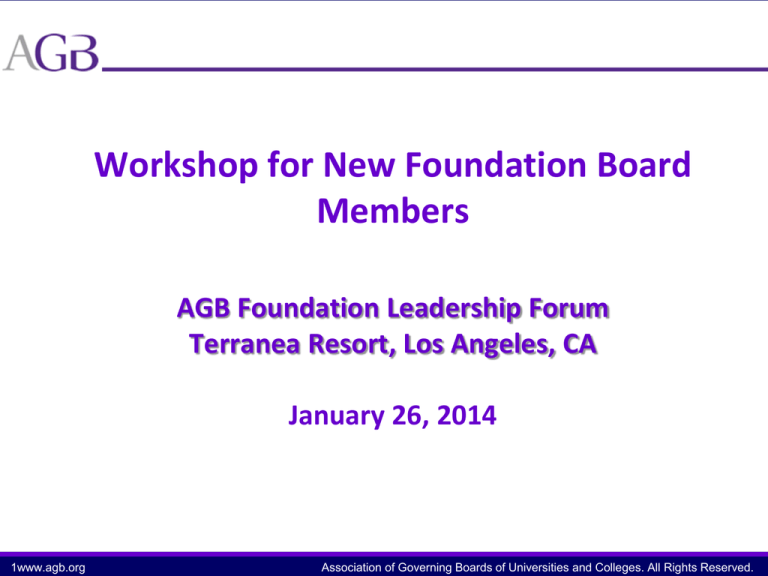
Workshop for New Foundation Board
Members
AGB Foundation Leadership Forum
Terranea Resort, Los Angeles, CA
January 26, 2014
1www.agb.org
Association of Governing Boards of Universities and Colleges. All Rights Reserved.
Presenters
Carol Cartwright
David Bass
Former president Kent State University and
Bowling Green State University and AGB
Consultant
Director, Foundation Programs and Research, AGB
DavidB@agb.org (202) 776-0850
ccartwri@kent.edu
2www.agb.org
Association of Governing Boards of Universities and Colleges. All Rights Reserved.
Agenda
• Current Contexts
• Principles
• Foundations’ Role in Supporting Public Higher Education
• Responsibilities of Foundation Boards
• Foundation Roles in Fundraising
• Structure, Staffing, and Funding
• Effective Foundation-Institution Partnerships
3www.agb.org
Association of Governing Boards of Universities and Colleges. All Rights Reserved.
About AGB
The Association of Governing Boards of Universities and Colleges is the only
national association that serves the interests and needs of academic
governing boards, boards of institutionally related foundations, and
campus CEOs and other senior-level campus administrators on issues
related to higher education governance and leadership. Its mission is to
strengthen, protect, and advocate on behalf of citizen trusteeship that
supports and advances higher education.
• AGB has more than 1.250 member institutions including colleges,
universities, and affiliated foundation
• Serve board members, presidents, and CEOs, senior administrators, and
board professionals
4www.agb.org
Association of Governing Boards of Universities and Colleges. All Rights Reserved.
Current Contexts
• Public institutions are being held to heightened standards of
accountability and governing boards are focusing increased attention
on financial oversight and risk management
• Increased needs for private support are leading many institutions to
explore changes to the structure of their development programs and, in
many cases, look to their foundation to play a more active role in
fundraising and assume responsibility for real estate projects
• Foundation boards’ obligation to ensure intergenerational equity has
become increasingly challenging
• Velocity of Leadership Transitions and competition for development
and investment talent
5www.agb.org
Association of Governing Boards of Universities and Colleges. All Rights Reserved.
Why Have a Foundation?--Practical
• Separation of privately contributed resources from state funds
• Facilitation of institutional objectives that would be impossible,
impractical, or simply inefficient for state agents such as real
estate acquisition and development, debt financed projects,
entrepreneurial ventures and partnerships
• Provision of dedicated stewardship and management of privately
contributed resources
• Safeguarding of donor privacy
6www.agb.org
Association of Governing Boards of Universities and Colleges. All Rights Reserved.
Why Have a Foundation? -- Strategic
• Philanthropic leadership (leadership gifts, prospect identification,
cultivation, and solicitation, campaign leadership)
• Engagement of volunteers with specialized expertise (investment
management, real property, etc.)
• Stewardship—Focus on compliance with donor intent
• Advocacy and advisory roles
• Continuity of leadership
7www.agb.org
Association of Governing Boards of Universities and Colleges. All Rights Reserved.
A Different Type of Board
Public Institution Boards
Foundation Boards
•
Institutions that are part of a system
may not have a separate board
•
Every institution can have its own
foundation
•
Appointed by governor or legislature
(or elected)
•
Self perpetuating
•
Recruited from dedicated supporters
•
Composition limited
•
Apolitical
•
Political
•
•
Broad range of responsibilities
Narrowly focused on fundraising,
management of contributed funds
•
Terms of service limited
•
Long-serving
8www.agb.org
Association of Governing Boards of Universities and Colleges. All Rights Reserved.
The Value of Volunteers
“Foundations turn outsiders into insiders”
• Stature and relationships with community/business leaders
• Philanthropic leadership
• Compelling advocates
• Technical and professional expertise
• Long-term perspective and visionary thinking
• Continuity of leadership
9www.agb.org
Association of Governing Boards of Universities and Colleges. All Rights Reserved.
Giving to Higher Education 1975 - 2010
(in billions)
$30.00
$27.33
$25.60
$25.00
$23.20
$20.00
$15.00
$12.75
$9.80
$10.00
$5.00
$7.40
$4.23
$2.41
$0.00
1975
1980
1985
1990
1995
2000
2005
2010
Association of Governing Boards of Universities and Colleges. All Rights Reserved.
Growth of Public Higher Ed Fundraising
Association of Governing Boards of Universities and Colleges. All Rights Reserved.
Public Institution Fundraising
Prior to the 1970s most public institutions had neither the
ability nor the need to seek significant private support.
In the past 4 decades public higher education fundraising
has grown exponentially -- volunteer-led foundations have,
in addition to their stewardship role, emerged as drivers of
public higher-education fundraising.
12www.agb.org
1990:
39% of $8.2 billion
2000:
43% of $19.4 billion
2010:
48% of $23.5 billion
Association of Governing Boards of Universities and Colleges. All Rights Reserved.
Fundamental Principles
• The Duty of Care requires full attention to one’s duties as trustee,
setting aside competing personal or professional interests insofar as
possible
• The Duty of Obedience refers to trustees’ obligation to promote the
mission of the organization within legal limits
• The Duty of Loyalty requires board members to put the interests of the
trust before all others
• The Duty to Serve the Public Interest in accordance with the
foundation’s status as a publicly supported charity
13www.agb.org
Association of Governing Boards of Universities and Colleges. All Rights Reserved.
Principles for Foundation Boards
• Absolute clarity regarding the roles, responsibilities, and
obligations of the institution and affiliated entities
• The foundation board is responsible for prudent management
and stewardship of privately contributed resources and may play
an important advisory role but does not determine institutional
priorities
• The foundation is a philanthropic partner; assets are generally
donor restricted. It is not an ATM.
• Trust of constituents depends on complete fiduciary
accountability
14www.agb.org
Association of Governing Boards of Universities and Colleges. All Rights Reserved.
Commitment to Accountability and Transparency
• Commitment to accountability should be guiding principle for all
parties
• Affiliated entities should comply with the highest standards of
transparency commensurate with the safeguarding of donor
privacy or sensitive confidential business information
• Trust, but verify. Ask uncomfortable questions
• Apply the smell test, newspaper test, and vampire test
• Avoid conflicts of interest
15www.agb.org
Association of Governing Boards of Universities and Colleges. All Rights Reserved.
Responsibilities of Foundation Boards I
• Maintain the foundation’s fiscal integrity, preserve and
protect its assets and provide financial oversight
• Ensure that the work of the foundation is aligned with the
strategic priorities of the host institution
• Work with the chief executive on the foundation’s longterm strategic plan, and participate in, approve, and
monitor progress of the foundation’s plan
16www.agb.org
Association of Governing Boards of Universities and Colleges. All Rights Reserved.
Responsibilities of Foundation Boards II
• Engage directly in fundraising, and provide diligent
stewardship of philanthropic contributions
• Advocate for the institution in keeping with its public
purpose and the state’s or county’s public agenda
• Support the foundation chief executive and provide
oversight as appropriate, given the position’s reporting
relationships
• Conduct the board’s business in an exemplary fashion and
periodically assess the performance of the board, its
committees, and its members
17www.agb.org
Association of Governing Boards of Universities and Colleges. All Rights Reserved.
Expectations of Foundation Board Members I
1. Articulate and support the foundation’s mission and
purpose
2. Develop a thorough knowledge of the institution’s mission,
strategic priorities, challenges, and opportunities
3. Understand and respect the distinct roles of the
foundation and institution boards
4. Accept the fiduciary responsibilities of foundation board
members and adhere to foundation policies and practices
5. Scrupulously avoid conflicts of interest and adhere to
foundation policy
18www.agb.org
Association of Governing Boards of Universities and Colleges. All Rights Reserved.
Expectations of Foundation Board Members II
6. Prepare for and participate conscientiously in board and
committee meetings, and other foundation activities
7. Exercise independent judgment, ask good questions, and
willingly share your time and expertise
8. Work collaboratively with the foundation chief executive,
other board members, and institution leaders
9. Advocate for the foundation and the host institution at
every opportunity
10. Set an example by personal giving and active participation
in the fund-raising process
19www.agb.org
Association of Governing Boards of Universities and Colleges. All Rights Reserved.
Foundations’ Role in Fundraising (4-Year/2-Year)
• 34% / 43% are wholly responsible for fundraising for their
institutions
• 10% / 31% direct fundraising with support from institution staff
• 44% / 23% support fundraising that is directed by institution staff
• 8% / 2% play little or no role
• 2015: 27% report that some responsibility for some
development functions has been transferred from the institution
to the foundation in past 5 years
20www.agb.org
Association of Governing Boards of Universities and Colleges. All Rights Reserved.
Boards’ Participation in Fundraising
• Foundation Boards’ contribute an average of 14% of total
support raised by public institutions
• Foundation board members contributed 21% of funds
raised during the quiet phase of campaigns vs. 4%
contributed by governing board members
• 88% of foundation boards participate in the cultivation and
solicitation of gifts, 80% in campaign leadership
• 2014: 54% report that board has become more active in
fundraising leadership in the past 5 years.
AGB: 2010
21www.agb.org
Association of Governing Boards of Universities and Colleges. All Rights Reserved.
Advocacy
Greater numbers of foundation board members now
advocate on behalf of the institution with legislators
• 1995 AGB Foundation Survey: 42.7% serve as advocates
• 2011 AGB Policies, Practices and Composition of
Foundation Boards: 65.9% serve as advocates
• 2015 AGB Poll: 57% report that the foundation board
has assumed greater importance as an ambassador and
advocate since 2010
22www.agb.org
Association of Governing Boards of Universities and Colleges. All Rights Reserved.
Other Changes in Foundation Roles since 2010
• 42% Foundation board has assumed increased responsibility for
real property projects and/or other entrepreneurial ventures
• 32% Foundation board is more actively engaged in an advisory
capacity to institution administrators
• 27% Responsibility for some development functions has been
transferred from the institution to the foundation
• 14% Responsibility for some development functions has been
transferred from the foundation to the institution
• 14% No major changes in foundation role in the last 5 years
23www.agb.org
Association of Governing Boards of Universities and Colleges. All Rights Reserved.
Operational Independence
Is operational independence important?
• Changed legal context and public climate
• Some functional independence can enhance accountability
• May be important to safeguard donor privacy and strategic
business information
• May be necessary to preserve ability to operate as a private
(non-state) entity
• Foundations with the capacity to self-fund can fire-wall
development investment and enhance staff recruitment
and retention
24www.agb.org
Association of Governing Boards of Universities and Colleges. All Rights Reserved.
Integration
Degree of Integration
2-Year
4-year
Dependent
44%
24%
(Effectively functions as a unit of the institution which provides office space, staff, other support)
Interdependent
49%
49%
(Receives some free in-kind benefits, such as office space, service of university employees)
Independent
7%
28%
(Operates with a high level of autonomy and reimburses the university of the use of institutional resources)
AGB 2011
25www.agb.org
Association of Governing Boards of Universities and Colleges. All Rights Reserved.
Foundation Board Independence
• As a fiduciary body it must be invested with authority commensurate
with its responsibilities
• Can provide an important control
• An independent board is still bound by its mission, the fundamental
duties of care, loyalty, and obedience, and the obligation to fulfill its
public purposes
• Rogue foundation boards are rare
• Benign neglect and a failure to clearly define expectations and reinforce
them through orientation, ongoing education, and assessment are all
too common
26www.agb.org
Association of Governing Boards of Universities and Colleges. All Rights Reserved.
Foundation Chief Executive
52% of foundation CEOs also serve as officers of the university
Compensation & Reporting
Paid by foundation/reports to board
27%
Paid by foundation/ dual report
9%
Paid by both/dual report
13%
Paid by institution/ reports to president
17%
Paid by institution/ dual report
34%
27www.agb.org
Association of Governing Boards of Universities and Colleges. All Rights Reserved.
Staffing
• Truly independent staffing and infrastructure requires a significant
endowment (less if the foundation is primarily an asset manager)
• University staffing ensures clear reporting lines and seamless alignment
of institution priorities and the work of the foundation
• Lack of dedicated staff may undermine the effectiveness and leadership
potential of the board
• Dual reporting relationships are the most common model but can, at
times, pose challenges for the incumbent
• If a board is charged with meaningful responsibilities they must be
provided with the resources required to fulfill those responsibilities
28www.agb.org
Association of Governing Boards of Universities and Colleges. All Rights Reserved.
Common Revenue Sources—Percentage Utilizing– from 2010 CASE
Survey
Funding Sources
Percent
1. Institutional support
50.6%
2. Unrestricted gift funds
63.1%
3. Gift funds restricted for foundation operations
18.8%
4. Investment income on unrestricted gifts
45.6%
5. Investment earnings or cash float on non-endowed restricted
gifts
50.6%
6. Management fee on endowed funds
72.5%
7. Gift fee(s)
33.1%
8. Revenue from real estate under management
20.6%
Association of Governing Boards of Universities and Colleges. All Rights Reserved.
As a Percentage of Foundation Funding (mean) – from 2010
CASE Survey
Funding Sources
Percent
1. Institutional support
19.8%
2. Unrestricted gift funds
20.1%
3. Gift funds restricted for foundation operations
3.3%
4. Investment income on unrestricted gifts
6.6%
5. Investment earnings or cash float on non-endowed restricted
gifts
9.2%
6. Management fee on endowed funds
27.4%
7. Gift fee(s)
3.9%
8. Revenue from real estate under management
3.7%
Association of Governing Boards of Universities and Colleges. All Rights Reserved.
Hallmarks of Effective Partnerships
• Clarity and consensus about the role of the foundation
– MOU
• Integrated planning and the alignment of strategic priorities
– Financial, annual development priorities, campaigns
• Trust, candor, and regular communication
• Formal and transparent business practices
• Flexibility
31www.agb.org
Association of Governing Boards of Universities and Colleges. All Rights Reserved.
The Impact of Foundations
“… by and large, what we’re working on today is
going to have the greatest benefit to the university
15, 20, 25 years from now.”
Gary Bloom, founding chair, Cal Poly Foundation
“Working Toward a Working Foundation Board”
32www.agb.org
Association of Governing Boards of Universities and Colleges. All Rights Reserved.
AGB Member Resources
• AGB Knowledge Center, sample documents, and policies
• Regional meetings
• Online discussion lists for foundation executives, attorneys, and board
professionals
• Trusteeship Magazine, research reports, books, and other publications
• Foundation consulting service and consultant on call
• If you have a question please just give us a call
David Bass, (202) 776-0850 DavidB@AGB.org
33www.agb.org
Association of Governing Boards of Universities and Colleges. All Rights Reserved.


